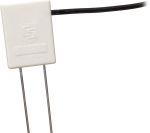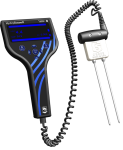
Designed for long-term monitoring






Overview
The CS616 measures the volumetric water content from 0% to saturation. The probe outputs a megahertz oscillation frequency, which is scaled down and easily read by a Campbell Scientific datalogger.
Read MoreBenefits and Features
- Compatible with most Campbell Scientific data loggers
- High accuracy and high precision
- Fast response time
- Designed for long-term unattended water content monitoring
- Compatible with AM16/32-series multiplexers, allowing measurement of multiple sensors
- Probe rods can be inserted from the surface or buried at any orientation to the surface.
Images

Detailed Description
The CS616 is comprised of two 30-cm-long stainless steel rods connected to the measurement electronics. The circuit board is encapsulated in epoxy, and a shielded four-conductor cable is connected to the circuit board to supply power, enable probe, and monitor the output.
The CS616 measures the volumetric water content of porous media (such as soil) using the time-domain measurement method; a reflectometer (cable tester) such as the TDR100 is not required. This method consists of the CS616 generating an electromagnetic pulse. The elapsed travel time and pulse reflection are then measured and used to calculate soil volumetric water content.
Response Characteristics
The signal propagating along the parallel rods of the CS616 is attenuated by free ions in the soil solution and conductive constituents of the soil mineral fraction. In most applications, the attenuation is not enough to affect the CS616 response to changing water content, and the response is well described by the standard calibration. However, in soil with relatively high soil electrical conductivity levels, compacted soils, or soils with high clay content, the calibration should be adjusted for the specific medium. Guidance for making these adjustments is provided in the operating manual.
Compatibility
Please note: The following shows notable compatibility information. It is not a comprehensive list of all compatible products.
Dataloggers
| Product | Compatible | Note |
|---|---|---|
| CR1000 (retired) | ||
| CR1000X (retired) | ||
| CR1000Xe | ||
| CR300 (retired) | ||
| CR3000 (retired) | ||
| CR310 | ||
| CR350 | ||
| CR6 | ||
| CR800 (retired) | ||
| CR850 (retired) |
Additional Compatibility Information
RF Considerations
The RF emissions are below FCC and EU limits as specified in EN61326 if the CS616 is enabled less than 0.6 ms, and measurements are made less frequently than once a second. External RF sources can also affect the CS616 operation. Consequently, the CS616 should be located away from significant sources of RF such as ac power lines and motors.
Installation Tool
The CS650G makes inserting soil-water sensors easier in dense or rocky soils. This tool can be hammered into the soil with force that might damage the sensor if the CS650G was not used. It makes pilot holes into which the rods of the sensors can then be inserted. It replaces both the 14383 and 14384.
Data Logger Considerations
The reflectometer connects directly to one of the data logger’s single-ended analog inputs. A data logger control port is typically used to enable the CS616 for the amount of time required to make the measurement. Data logger instructions convert the probe square-wave output to period which is converted to volumetric water content using a calibration.
Specifications
| Measurements Made | Volumetric water content (VWC) of porous media (such as soil) |
| Measurement Range | 0% to saturation |
| Water Content Accuracy | ±2.5% VWC (using standard calibration with bulk EC of ≤ 0.5 dS m-1, bulk density of ≤ 1.55 g cm-3, and measurement range of 0% to 50% VWC) |
| Required Equipment | Measurement system |
| Soil Suitability | Long rods and lower frequency are well-suited for soft soil with low electrical conductivity (< 2 dS/m). |
| Rods | Not replaceable |
| Sensors | Not interchangeable |
| Operating Temperature Range | 0° to +70°C |
| Probe-to-Probe Variability | ±0.5% VWC in dry soil, ±1.5% VWC in typical saturated soil |
| Precision | Better than 0.1% VWC |
| Resolution | 0.1% VWC |
| Output | ±0.7 V square wave (with frequency dependent on water content) |
| Current Drain |
|
| Power Supply Voltage | 5 Vdc minimum; 18 Vdc maximum |
| Enable Voltage | 4 Vdc minimum; 18 Vdc maximum |
| Electromagnetic | CE compliant (Meets EN61326 requirements for protection against electrostatic discharge.) |
| Rod Spacing | 32 mm (1.3 in.) |
| Rod Diameter | 3.2 mm (0.13 in.) |
| Rod Length | 300 mm (11.8 in.) |
| Probe Head Dimensions | 85 x 63 x 18 mm (3.3 x 2.5 x 0.7 in.) |
| Cable Weight | 35 g per m (0.38 oz per ft) |
| Weight | 280 g (9.9 oz) without cable |
Documents
Frequently Asked Questions
Number of FAQs related to CS616: 3
Expand AllCollapse All
-
If the CS615 rod length is reduced, the response of the probe to water content will change, and the recommended calibration is no longer valid. Additionally, reducing rod length will adversely affect the water content measurement resolution. However, the CS615 will respond in a similar manner to the response with standard length rods (30 cm). The response needs to be described for the modified probe to generate a calibration. CS615 water content resolution is better than 0.2% volumetric water content with 30 cm rods. If the rods are cut by 15 cm, water content resolution will be between 1% and 2%. A few additional points are:
- Probes with rods less than 15 cm may be unstable.
- A calibration of CS615 output to volumetric water content will have to be established using field or laboratory measurements. Field calibration measurements can be made by recording the CS615 period with the probe in soil, removing the probe and taking samples of known volume for use with gravimetric water contents.
- Water content measurement resolution will be affected.
- Cutting the rods will void their warranty.
-
The CS616 has a faster period output than the CS615-L, so it does not work with the 21X dataloggers.
-
- The CS616 and CS625 meet European noise emission standards, which are stricter than U.S. standards.
- The CS616 and CS625 period output is more linear than the CS615-L output.
- The CS616 and CS625 operate over a wider range of soil types than the CS615-L.
- The CS616 and CS625 have improved electrostatic discharge protection.
- The CS616 and CS625 use surface-mount components with better frequency response, which is important for dielectric permittivity sensitive sensors.
- A dedicated data logger instruction, CS616() in CRBasic and P138 in Edlog, makes CS616-L programming easier and produces a faster measurement. Similarly, a dedicated data logger instruction, PeriodAvg() in CRBasic, makes CS625-L programming easier and produces a faster measurement.
- The CS616 and CS625 have less probe-to-probe variability than the CS615-L.
Casos de estudio
Tropical volcanic islands are biodiversity hotspots where the Critical Zone (CZ) remains poorly studied. In......read more
The Delaware Environmental Observing System (DEOS) is a real-time system dedicated to monitoring environmental conditions......read more
The West Texas Mesonet (WTM) project was initiated by Texas Tech University in 1999 to......read more









